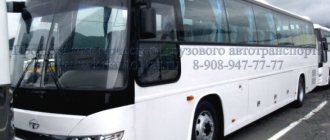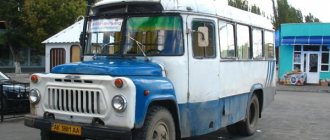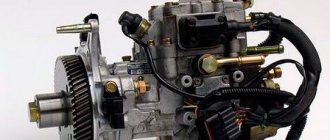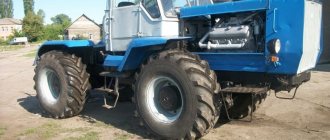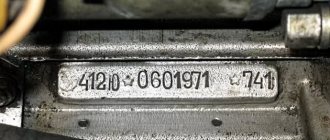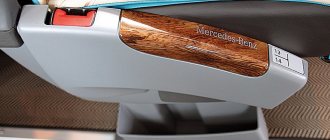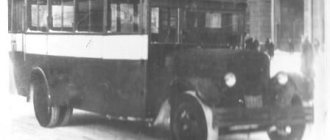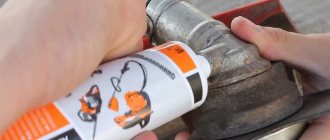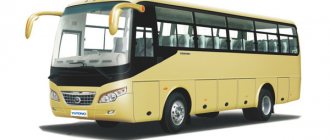New Setra buses of the second series have not been produced for a long time, and used ones practically do not arrive to us - due to brutal duties on equipment older than seven years. But there are still a lot of such machines in operation in the CIS, and they are highly valued - both by shuttle operators and large carriers. We talk about these buses and the features of their operation.
Two representatives of the second series: in the foreground - Setra S217 HDH (1997), behind it - S213RL (1988).
In the “table of ranks” of bus carriers, used Setra liners of the second series are located between the Mercedes and Neoplan brands: these cars were not as identical as the Mercs, but also not as exclusive and individual in configuration as the Neoplans.
They were produced for more than twenty years - from 1976 to 1997. Today, these buses practically no longer come to Russia: after all, for customs clearance of cars produced more than seven years ago, you have to pay three euros per “cube” of working volume!
But there are still plenty of such buses, imported in previous years, on our roads - and now wealthier carriers, updating their fleet, are selling these cars to third parties. “It is impossible to buy a Zetra in more or less good condition for less than 20 thousand euros today. Anything cheaper is a completely dead car,” experts say.
But, oddly enough, there are also perfectly preserved specimens! An example of this is the bus we will talk about.
FROM BORDER GUARDS TO FIREFIGHTERS
In the spring of 2004, German border guards presented our Ministry of Emergency Situations with three Setra S213RL buses - painted, as expected, dark green, with flashing lights and sirens (we talked about this back in AR No. 7, 2004).
- This Setra S213RL used to transport German border guards, and now works for the Ministry of Emergency Situations
- The interior, even in the “suburban” version, is very comfortable. And the glass doesn't freeze
The firefighters who received one of the cars consider it a gift from fate: a copy, produced in 1988, came to Russia with only 207 thousand km on the clock and in almost perfect condition - after all, it did not work on the route, but carried border guards “from the checkpoint to the headquarters and back".
It should be noted that the Germans were meticulous in their pre-sale preparation: not only did the bus undergo full technical maintenance before delivery to us (as evidenced by the marker on the engine support), but all the seats in the cabin were also replaced.
True, the picture was spoiled by a stay at Russian customs: all the speakers, radio, amplifier, even a voltage converter from 24 to 12 V were stolen from the interior, cutting through the upholstery. One of the exterior mirrors also disappeared, and with it the ax from the luggage compartment...
Over the past two years, the car - already repainted in a “radical white” color - has traveled about 30 thousand km on Russian roads. Firefighters can't get enough of it: the engine is high-torque, the interior is quiet, the double-glazed windows don't fog up, the heating and ventilation are excellent. But it wasn't without problems.
DISEASE HISTORY
Since the air suspension of the “borderline” Zetra was configured for German flat roads, the bus’s stern hit literally everything that came along the way: snowdrifts, curbs... Even the exhaust tract (it runs under the engine) was dented on one of the potholes. I had to increase the ground clearance - fortunately the suspension design allows this.
In the very first winter, a large piece of the plastic engine protection broke off under the weight of accumulated snow (by the way, it is officially called the “encapsulation panel”). The pallet was replaced with a homemade one - now made of iron.
- Behind the hatch on the front is a spare tire and a removable washer reservoir
- The pedantic Germans wrote the mileage and date of the last maintenance on the engine.
- There are no pipes or hoses on the bottom. Independent front suspension clearly visible
- Autonomous stove is sensitive to low-quality diesel fuel
And this winter there were problems with the front brakes: the pads began to jam in the drums. At one of the capital's automobile plants, the reason was established: the front brake chambers simply rotted. Apparently, they had not been changed before, and the capital’s road reagents completed the job, “corroding” the housing.
Having changed the cameras, the bus was also given maintenance - the oil and filters were replaced. However, it later turned out that the mechanics did not tighten the filter cups properly: in the cold, diesel fuel began to ooze out of there. I had to correct the situation myself.
Then, when the frost reached -20°C, the pre-heater stopped starting - this time due to the fault of bad diesel fuel (and starting an engine in cold weather without “autonomy” is a big problem). Again, I had to disassemble the heater “boiler” myself. At –30°C, the rear suspension air springs lost their elasticity and began to leak air. I had to change them.
- With proper maintenance, the engine (in the picture is a naturally aspirated OM 422) runs up to 1.5 million km
- The owners exchange the plastic engine protection for a homemade iron one. The muffler is still intact, but the exhaust pipe of the “autonomy” has already rotted
- At customs, all the speakers were ripped out of the interior of the “border” Zetra
Electricians also cause a lot of trouble (most likely due to old age): the side light fuses often blow.
And with almost 250,000 miles on the bus, it was decided to carry out diagnostics. We, together with the owners of the car, went to the service station. The diagnosis is as follows: there is play in the left tie rod, wear on the silent block of the upper left arm of the front suspension, a crack along the seam of the exhaust pipe, the Webasto exhaust pipe is rotten, the muffler will soon require repair.
But overall, it’s okay. The car is in very good condition!
There is no limit to perfection
In terms of manufacturing technology, a bus is an order of magnitude simpler than a passenger car and an order of magnitude more expensive, at least in terms of the number of parts and technologies. Tourist liners are the elite of passenger transportation. They richly combine the best qualities of all classes of buses.
Setra regularly updates the engine, transmission and chassis. In-line 6-cylinder turbodiesel engine OM 471 with a displacement of 12.8 liters and a power of 510 hp. replaced the previously used V8. This engine was last modernized in 2016 due to the introduction of Euro 6 standards. Common Rail direct injection with a unique flexible high-pressure X-Pulse injection system; modified combustion chamber geometry with a higher compression ratio, patented exhaust gas recirculation process with flexible control of the reverse flow rate, asymmetric injection. Thanks to the fixed turbine geometry of the new turbocharger, it was possible to get rid of the wastegate valve and remove the EGR sensor, which only increased the reliability of the unit. Much attention is paid to acoustic comfort. In the rear seats of the second floor, the noise does not exceed 60 dBA.
The Setra S 531 DT is the first Daimler Buses coach bus in the world to be equipped as standard with a fire extinguishing system in the engine compartment. A warning lamp and a buzzer warn the driver of the danger. After this, a mixture of fire extinguishing agents is sprayed into the compartment through the fire extinguisher nozzles under high pressure, which sharply cools the engine and systems.
The GO 250-8 PowerShift 8-speed automatic transmission transmits torque to the RO 440 drive axle. Intelligent Powertrain Control (PPC) and Eco Driver Feedback (EDF) allow it to adapt to your individual driving style. Rear axle, actively steered, with independent wheel suspension.
Technical characteristics of Setra S 531 DT (6×2)
| Permissible total weight, kg | 26 400 |
Engine:
| Mercedes-Benz OM 471, turbodiesel, I-6, Euro 5 12 809 510 at 1600 min-1 2500 at 1100 min-1 |
| Transmission | Mercedes-Benz GO 250-8 PowerShift, GMP, 8-speed |
| Front suspension | 5,92 |
| Rear suspension | Pneumatic |
| Steering axle | ZF RL 75 EC |
| Final drive ratio | 3,583 |
| Brake system | Pneumatic, with EBS and ABA |
| Turning diameter, m | 23,14 |
| Braking mechanisms of all wheels | Disk |
| Tire size | 315/80 R22.5 |
| Fuel tank capacity, l | 480 |
| AdBlue tank capacity, l | 40 |
| Number of places for 3/4 star classification | 83/ 78 |
| Capacity of luggage compartments/luggage shelves, m3 | 8,4/ 1,2 |
FROM A MECHANIC'S PERSPECTIVE
However, according to the mechanics, the second generation Setra buses themselves are very reliable and unpretentious. It is interesting that engines of different brands were installed on them: in those years, Setra was independent, and not part of a single concern with the Mercedes brand, as it is today. But even before that, most often - on about three out of four buses - Mercedes engines were installed: either V6 or V8 (with indexes OM421 or 422, respectively). As an alternative, MAN inline sixes were installed - either the D2856 or the D2566, well known to truck drivers. Those and other engines existed in various versions: naturally aspirated, turbocharged, with intercooler.
But regardless of the model, these engines can last up to one and a half million kilometers without major repairs. And these are not loud words: in motorcade No. 1417, where the service station is located, there are such specimens. It turns out that cars received from Germany with already 800 thousand mileage can last the same amount without major repairs!
True, under one condition: regular and competent maintenance (by the way, it is better to change the oil every 15-20 thousand km, and you can easily get by with inexpensive mineral water).
Of course, in our conditions, the body suffers the most: over the years, the skin rusts, the frame trusses rot. But here a lot again depends on the owners.
However, the attitude of our carriers towards equipment (which carries not cargo, but people!) deserves a separate discussion...
“We once brought a “second” Zetra, owned by a private owner, on a tow truck for repairs,” say experts. — The driver is complaining: the brakes have failed, do something. It turned out that the brake pipes going to the three wheels were completely plugged! First, the rear brakes failed - the driver, without thinking twice, turned them off. Then the mechanism of one of the front wheels broke. The unfortunate owner turned it off too. And he braked with just one wheel (!) until the brakes completely failed..."
Another owner decided to repair the axle shaft himself. And it got jammed - well, not while driving, but while being towed for repairs! What can I say? Either stand or fall.
Comfort for the pilgrim
Just 50 years ago, shiny interior details were a sign of a bus’s chic. Now such a feature is the TopSky glazed roof. However, it is included in the list of options. As an element of comfort on a long journey - a transparent roof. According to the observation of some passengers, it causes fatigue towards the end of the trip. In general, it is recommended to use it on tourist trips, not intercity trips.
Setra Voyage Plus first class (4*) buses are equipped with seats and wall panels upholstered in black and blue or ocher-gray Vanity grey. Armchairs must have adjustable headrests made of composite leather-velor materials. The use of energy-saving LED lamps and LCD monitors in the cabin made it possible to significantly reduce the load on the electrical network and install a double USB socket with LED backlight and a 220 V socket on the wall near the seats.
Through the USB interface you can watch TV programs, listen to music or a guide. The broadcast is carried out from a DVB-T2 tuner through a media router.
To ensure constant energy consumption, the machine has two separate batteries. Vacuum systems for plumbing, cooking and food storage are powered in parallel from them.
In the 3-star version, there is no headrest adjustment - only the tilt of the seat back and the lateral shift of the seat cushion. Such options are the most popular in regular operation and therefore are often used for intercity routes. But then there are requirements for equipping places for wheelchairs. However, tour operators, which have their own low-cost segment, are also ready to buy such cars.
The kitchen unit has two Frenzel coffee machines, each with a capacity of 40 cups, and a sink. Cooling drinks are located in the front panel, in the refrigerated box. So passengers will not be left without a hot snack on the road.
Modern intercity liners for long-distance travel are unthinkable without a bathroom, especially when there are 80 passengers on board. The toilet cubicle is located opposite the rear door and is equipped with a washbasin, mirror and hairdryer. In an attempt to highlight the millimeters, the toilet was placed diagonally.
"ORIGINAL" OR "NON-ORIGINAL"?
The most common “second” Setra is the tourist S215H. The condition of this example leaves much to be desired: the body is rotten, the windshield is cracked... At the same time, the car carries children!
There are, of course, not very many spare parts for old imported buses (including the “second” Zetra) in our country - but they still exist.
For example, sellers do their best to advertise used spare parts taken from “killed” buses, cut up at sites in Germany. At the same time, it is argued that there is no point in installing a new part on a car manufactured before 1995 - anyway, they say, it will soon fall apart.
But such savings can backfire - if not a serious accident. If only because in the list of used spare parts offered by a certain company, we found the following notes intended “for internal use.” “Pistons. Large ellipsoidal, but still similar” (interesting to know how much? - AR). “Clutch master cylinder. Looks like a worker. Let go only after the client looks.” "Webasto. Externally good, but working condition unknown.” And finally: “Setra 215 cardan shaft. Price 11,999 rubles. Doesn't move back and forth. We need to stir it up...” But what if the sellers manage to “push” this cardan and it gets jammed on the move?!
- The original SKF bearing (right) costs 131 euros. And the non-original one (on the left) costs about 900 rubles
- The original air spring for the suspension costs 4,819 rubles. Non-original - 681 rubles
- This is how used bus parts are advertised on the Internet. The sellers couldn’t even spell the word “retarder” correctly... And the condition of the unit gives rise to great doubts
Yes, a new and original cardan is twice as expensive. But a new and known-to-be-good “non-original” one costs even less - 10,482 rubles.
In general, the situation with new spare parts deserves a separate description. “Only original parts ensure safety!” - screams the headline in the branded Mercedes magazine Omnibus. But any competent carrier knows very well: often the “non-original” is no worse than the “original”, but the difference in price is huge.
Absolutely identical Sachs shock absorbers (only in different packages) will cost 6,150 and 4,206 rubles, respectively. The “original” SKF wheel bearing is more than three times more expensive than a non-original one (but also made at an SKF group enterprise).
The difference in the price of the front suspension air spring is absolutely amazing: a German one costs 4,800 rubles, a Turkish one costs less than 700 rubles. “But it’s not that simple,” the mechanics say. — You can, of course, stuff cheap Turkish cylinders into the trunk and change them regularly on the highway. But we cannot afford this: our buses run strictly on schedule. And that’s why we install expensive but obviously reliable German pneumatic elements on our cars.”
Of course, cars don’t get any younger over the years, especially on our roads. But we ask those who work on old imported buses: do not skimp on spare parts. After all, the lives of dozens of passengers depend on their quality! And the ultimate of our dreams is if all owners of old buses regularly underwent diagnostics: for just a thousand rubles (the average cost of a standard hour at a good bus service) you can get a detailed list of problems and malfunctions. But we have very few such services. And there are even fewer people who want to visit them...
AR Help. The editors would like to thank the technical center at motorcade No. 1417 in Kolomna for information support. Telephone. Code for Moscow and the region (26).
| Prices for new spare parts for Setra buses of the second series, rub. | "original" | "non-original" |
| Rear shock absorber, Sachs | 6150 | 4206 |
| Wheel bolt M22x1.5x60 | 310 | 91 |
| Cardan shaft | 21653 | 10482 |
| Generator 28V 140A | 42000 | 27741 |
| Front brake disc | 10200 | 3400 |
| Brake pad | 844 | 387 |
| Rear brake pads | 14314 | 2172 |
| Rear brake drum | 7378 | 5127 |
| Floor level regulator | 9518 | 4295 |
| Air filter | 2414 | 678 |
| Fuel filter | 442 | 85 |
| Outer hub bearing | 3215 | 867 |
| Internal hub bearing | 8160 | 1428 |
| Front air spring | 4800 | 681 |
| Rear air spring | 3900 | 990 |
One look back
Serial production of Setra buses of the second series began thirty years ago - in 1976. Interestingly, such a model was first shown at the Geneva Motor Show four years earlier.
The design of the bus was distinguished by a number of solutions that were unusual for those times. The front suspension is pneumatic and independent, the side windows are glued in (remember: this was more than thirty years ago!), and the interior ventilation is through invisible cracks under the roof. And in 1984, Setra became the first bus in the world to be equipped with ABS as standard.
In 1991, production of the third generation began - more modern, elegant, “electronic”... And, of course, more expensive. But the production of buses of the second series - simple and unpretentious - continued for another six years, until 1997! Moreover, in recent years, new versions have been developed - the most simplified S250 Special and the most luxurious S217 HDH (three-axle 13.7-meter liner).
Interestingly, three-axle buses were also supplied to the USA, and with locally produced units - a Detroit Diesel engine and an Eaton gearbox. In total, only until 1991, 27,680 buses of the second series were built in Germany.
In addition, quite a few cars were assembled externally, under license, in Spain (almost 2000 copies), Greece and Turkey. And since 1993, the “200th” Setra was also produced in China: its production there ceased only three years ago.
Nikolay Sidelev, director of motorcade No. 1417:
The “second” Setra is a classic! Simple, reliable, unpretentious... I once visited Spanish transport workers, and they said: “When we drove the Zetras of the second series, we were happy. When we switched to the third series, we began to think about it. And with the fourth episode problems began..."
And if five to seven years ago our shuttle business was based on “killed” Ikarus buses, today, according to our calculations, almost 80% of private owners travel on Setra buses of the second series! We have about 20 such buses in our convoy - and not a single one has been written off yet.
It's a pity that you can't buy cars like this abroad anymore. But the third series is completely different: there are more electronics and the design is more complex.
Description and device
The buses of the model range had an all-metal body of a supporting structure with a rear-engine layout. The buses are equipped as standard with Daimler-Benz diesel engines ; MAN units were installed as an option. Tourist buses were equipped with 6-speed manual ZF gearboxes, while city buses were equipped with 4-speed automatic ZF Ecomat gearboxes.
In the design of the car, what caught the eye first was the shape of the “front” with a solid windshield and glued glass. The latter were a real technical novelty at the time of their appearance. For the first time in Setra's history, the buses featured disc brakes and air suspension . Another feature was the passenger compartment ventilation system. The air entered through the cracks above the windows, covered with decorative plastic elements, after which it was evenly distributed throughout the cabin by an individual ventilation system.
From the driver's point of view
We didn't expect that a bus produced 18 years ago would be so pleasant to drive!
The driver feels simply wonderful here: the seat, although simple in design, is extremely comfortable; The pedals are “soft” (surprisingly, so is the clutch) and informative, the gears shift clearly: even if you’re not used to it, you won’t miss a beat. Perhaps the only thing you can find fault with is the “empty” steering wheel (which is a bit of a hindrance when overtaking).
But the empty bus itself makes overtaking effortlessly. If you bump into the car in front, you simply let off the gas, and then, when overtaking, you press the pedal - and the bus quickly accelerates to 120 km/h. I can’t even believe that there is no turbocharging here! The driver's heater is very powerful (if you turn it on at full power, you can get fried), the windows don't even think about frosting or fogging up... Cool car.
